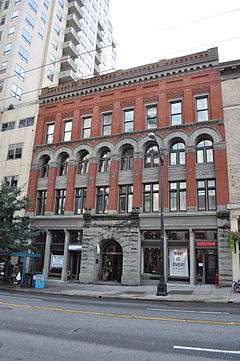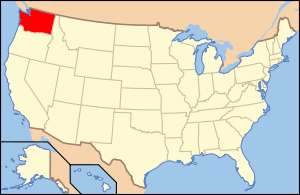Grand Pacific Hotel (Seattle)
|
Grand Pacific Hotel | |
|
The Grand Pacific Hotel, September 2007 | |
| Location | 1115-1117 1st Ave., Seattle, Washington |
|---|---|
| Coordinates | 47°36′36″N 122°20′10″W / 47.61000°N 122.33611°WCoordinates: 47°36′36″N 122°20′10″W / 47.61000°N 122.33611°W |
| Built | 1890 |
| Architectural style | Richardsonian Romanesque |
| NRHP Reference # | 82004236[1] |
| Added to NRHP | May 13, 1982 |
The Grand Pacific Hotel (first known as the California Block[2] or the Starr Building) is a historic building in Seattle located at 1115-1117 1st Avenue between Spring and Seneca Streets in the city's central business district. The building was constructed in 1890 [Often incorrectly cited as 1898] during the building boom that followed the Great Seattle Fire of 1889. The building had served as a hotel nearly since its construction, with the Ye Kenilworth Inn, operated by Minnie Hayward, on the upper floors in 1893. The hotel was refurnished and reopened in 1902 as the Grand Pacific Hotel, most likely named after the hotel of the same name in Chicago. It played a role during the Yukon Gold Rush as one of many hotels that served traveling miners and also housed the offices for the Seattle Woollen Mill, an important outfitter for the Klondike.[3]
The Grand Pacific Hotel is a substantial four-story brick and stone building designed in the Richardsonian Romanesque style and remains a rare surviving example of its kind outside of the Pioneer Square district. The building's original architect is not known. It was listed on the National Register of Historic Places in 1982 around the same time as the adjacent Colonial Hotel.
History
The Grand Pacific Hotel was one of hundreds of substantial brick buildings constructed in the aftermath of the Great Seattle Fire. It was constructed as the California Block for the estate of the late Lewis M. Starr by his widow Eliza J. Starr, the executor of the estate.[4] it was built at a cost of $75,000 and as reported in the summer of 1890, $12,000 in stone, $3,000 in iron 1,200,000 bricks and 3,000 ft of lumber had gone into its construction.[5] Due to the dramatic slope of the property towards Elliott Bay, the four story building had two additional floors below 1st Avenue, which housed various industrial enterprises. For most of the decade it was the only building located on the block taller than one story. The Galt Brothers were the building's primary tenant in 1891 and The Seattle Woolen Mills would locate their offices in the lower floors during the Yukon Gold Rush.[2] Though designed for office space, as early as 1892, the building's upper floors were occupied by the Ye Kenilowrth Inn, operated by Minnie Hayward.[6] In 1902 it reopened as the Grand Pacific Hotel, which it is best known as today.
In 1913 the Starr estate sold the building to real estate investor A. Rodgers for $125,000.[7] In March 1914 the body of a young man was discovered in room 48, dead from an apparent suicide by ingesting Carbolic acid.[8] A.J. Johnson, the proprietor of the hotel at the time would commit suicide just over a year later.[9] In 1931 the building was nearly gutted by an early morning fire originating from one of the basement floors that vented through the hotel's central court, where flames were said to shoot 75 feet into the air. All 67 guests were either able to escape or were rescued by firefighters.[10]
The hotel continued to serve long-term guests up until October 1966, when Seattle slum clearing policies forced the now run-down hotel into Nuisance abatement. Citing prohibitive repair costs, the building's then owner, Kerry Timber Co., evicted all the residents and closed off the building's top floors indefinitely.[11] Beginning in the late 70s, The Grand Pacific and other historic buildings in the area were restored and redeveloped by Cornerstone Development Co, a subsidiary of Weyerhaeuser as part of the Waterfront Center project, which combined new construction with older buildings restored for housing.[12] During restoration, The Grand Central Hotel was interconnected with the Colonial Hotel to the north. The Grand Pacific Hotel was listed on the National Register of Historic Places on May 13, 1982.
See also
External links
- Grand Pacific Hotel, Seattle, ca. 1907 - from the Museum of History and Industry photo archives.
References
- ↑ National Park Service (2009-03-13). "National Register Information System". National Register of Historic Places. National Park Service.
- 1 2 Grant, Frederic James (1891). History of Seattle, Washington, with Illustrations and Biographical Sketches of Some of It's Prominent Men and Pioneers. New York: American Publishing and Engraving Co. p. 25. Retrieved 28 October 2016.
- ↑ History of the Grand Central Hotel relating to the Klondike Gold Rush at the National Park Service website. Accessed November 23, 2010.
- ↑ "The Starr Estate Affairs". The Seattle Post-Intelligencer. The Library of Congress. 6 Oct 1892. Retrieved 15 May 2016.
- ↑ "Walls of New Seattle; Records of Improvement in the Burnt District". The Seattle Post-Intelligencer. The Library of Congress. 6 Jun 1890. Retrieved 15 May 2016.
- ↑ "For Rent - A Few Charming Rooms". The Seattle Post-Intelligencer. The Library of Congress. 12 Sep 1892. Retrieved 14 May 2016.
- ↑ "Grand-Pacific Hotel Bought for $125,000". The Seattle Daily Times. Newsbank. 27 Feb 1913.
- ↑ "Mother Ill at Home, Son Takes Life Here". The Seattle Daily Times. Newsbank. 26 Feb 1914.
- ↑ "Former Hotel Man Ends His Own Life". The Seattle Daily Times. Newsbank. 23 Mar 1915.
- ↑ "67 Saved in Blaze Here". The Seattle Daily Times. Newsbank. 3 Feb 1931.
- ↑ "Two More of Old Seattle Hotels Closing". The Seattle Times. Newsbank. 28 Oct 1966.
- ↑ "Five Downtown Blocks to Be Renovated by Weyerhaeuser". The Seattle Times. Newsbank. 20 Mar 1980.


